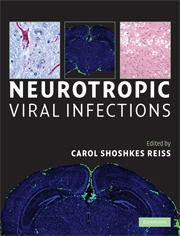Book contents
- Frontmatter
- Contents
- List of contributors
- Foreword
- Preface and acknowledgments
- Section I Introduction: RNA viruses
- Section II Introduction: retroviruses, DNA viruses, and prions
- 8 Human T-lymphotropic virus type 1 and disease in the central nervous system
- 9 HIV infection of the central nervous system
- 10 JC virus molecular biology and the human demyelinating disease, progressive multifocal leukoencephalopathy
- 11 The herpes simplex viruses
- 12 The pathogenesis of varicella-zoster virus neurotropism and infection
- 13 Transmissible spongiform encephalopathies
- Section III Introduction: immunity, diagnosis, vector, and beneficial uses of neurotropic viruses
- Index
- Plate section
- References
13 - Transmissible spongiform encephalopathies
from Section II - Introduction: retroviruses, DNA viruses, and prions
Published online by Cambridge University Press: 22 August 2009
- Frontmatter
- Contents
- List of contributors
- Foreword
- Preface and acknowledgments
- Section I Introduction: RNA viruses
- Section II Introduction: retroviruses, DNA viruses, and prions
- 8 Human T-lymphotropic virus type 1 and disease in the central nervous system
- 9 HIV infection of the central nervous system
- 10 JC virus molecular biology and the human demyelinating disease, progressive multifocal leukoencephalopathy
- 11 The herpes simplex viruses
- 12 The pathogenesis of varicella-zoster virus neurotropism and infection
- 13 Transmissible spongiform encephalopathies
- Section III Introduction: immunity, diagnosis, vector, and beneficial uses of neurotropic viruses
- Index
- Plate section
- References
Summary
Introduction
Transmissible spongiform encephalopathies (TSEs), also known as prion diseases, are a unique group of slowly progressive and invariably fatal infections of the central nervous system, which can occur in infectious, sporadic, and inherited forms. Some examples of TSEs include kuru and Creutzfeldt-Jakob disease (CJD) in humans, bovine spongiform encephalopathy (BSE) in cattle, chronic wasting disease (CWD) in deer and elk, transmissible mink encephalopathy (TME) in mink, and scrapie in sheep. The infectious agent of TSEs is an unconventional, proteinaceous entity, which has been termed a “prion.” Unlike conventional infectious agents such as viruses or bacteria, infectious prions are remarkably resistant to most physical or chemical inactivation methods and can form spontaneously in hosts unexposed to exogenous infection. The “protein only” hypothesis postulates that prions lack informational nucleic acids and are composed exclusively of an infectious protein termed PrPSc. Experimental evidence indicates that PrPSc molecules form through the misfolding of a host-encoded glycoprotein termed PrPC in an autocatalytic process. However, the molecular mechanism of prion formation and precise composition of infectious prions remain unknown. Currently, much research is focused on developing effective methods for presymptomatic diagnosis and therapy for TSEs, and recent advances toward these goals have been achieved.
The Infectious Agent
The precise nature of the TSE infectious agent has been the subject of great controversy for decades.
- Type
- Chapter
- Information
- Neurotropic Viral Infections , pp. 251 - 262Publisher: Cambridge University PressPrint publication year: 2008



